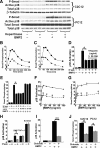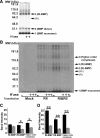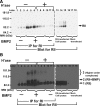Heparan sulfate acts as a bone morphogenetic protein coreceptor by facilitating ligand-induced receptor hetero-oligomerization
- PMID: 20861306
- PMCID: PMC2982130
- DOI: 10.1091/mbc.E10-04-0348
Heparan sulfate acts as a bone morphogenetic protein coreceptor by facilitating ligand-induced receptor hetero-oligomerization
Abstract
Cell surface heparan sulfate (HS) not only binds several major classes of growth factors but also sometimes potentiates their activities--an effect usually termed "coreception." A view that coreception is due to the stabilization of growth factor-receptor interactions has emerged primarily from studies of the fibroblast growth factors (FGFs). Recent in vivo studies have strongly suggested that HS also plays an important role in regulating signaling by the bone morphogenetic proteins (BMPs). Here, we provide evidence that the mechanism of coreception for BMPs is markedly different from that established for FGFs. First, we demonstrate a direct, stimulatory role for cell surface HS in the immediate signaling activities of BMP2 and BMP4, and we provide evidence that HS-BMP interactions are required for this effect. Next, using several independent assays of ligand binding and receptor assembly, including coimmunoprecipitation, cross-linking, and fluorescence fluctuation microscopy, we show that HS does not affect BMP binding to type I receptor subunits but instead enhances the subsequent recruitment of type II receptor subunits to BMP-type I receptor complexes. This suggests a view of HS as a catalyst of the formation of signaling complexes, rather than as a stabilizer of growth factor binding.
Figures







Similar articles
-
Heparan sulfate is required for bone morphogenetic protein-7 signaling.Biochem Biophys Res Commun. 2003 Sep 5;308(4):858-65. doi: 10.1016/s0006-291x(03)01500-6. Biochem Biophys Res Commun. 2003. PMID: 12927798
-
Structure analysis of bone morphogenetic protein-2 type I receptor complexes reveals a mechanism of receptor inactivation in juvenile polyposis syndrome.J Biol Chem. 2008 Feb 29;283(9):5876-87. doi: 10.1074/jbc.M706029200. Epub 2007 Dec 26. J Biol Chem. 2008. PMID: 18160401
-
The mode of bone morphogenetic protein (BMP) receptor oligomerization determines different BMP-2 signaling pathways.J Biol Chem. 2002 Feb 15;277(7):5330-8. doi: 10.1074/jbc.M102750200. Epub 2001 Nov 19. J Biol Chem. 2002. PMID: 11714695
-
Bone morphogenetic proteins.Growth Factors. 2004 Dec;22(4):233-41. doi: 10.1080/08977190412331279890. Growth Factors. 2004. PMID: 15621726 Review.
-
Specification of BMP Signaling.Cells. 2019 Dec 5;8(12):1579. doi: 10.3390/cells8121579. Cells. 2019. PMID: 31817503 Free PMC article. Review.
Cited by
-
Exogenous heparin binds and inhibits bone morphogenetic protein 6 biological activity.Int Orthop. 2013 Mar;37(3):529-41. doi: 10.1007/s00264-012-1714-3. Epub 2013 Jan 10. Int Orthop. 2013. PMID: 23307015 Free PMC article.
-
Hepatic heparan sulfate is a master regulator of hepcidin expression and iron homeostasis in human hepatocytes and mice.J Biol Chem. 2019 Sep 6;294(36):13292-13303. doi: 10.1074/jbc.RA118.007213. Epub 2019 Jul 17. J Biol Chem. 2019. PMID: 31315930 Free PMC article.
-
Heparin microparticle effects on presentation and bioactivity of bone morphogenetic protein-2.Biomaterials. 2014 Aug;35(25):7228-38. doi: 10.1016/j.biomaterials.2014.05.011. Epub 2014 May 28. Biomaterials. 2014. PMID: 24881028 Free PMC article.
-
Hepcidin antagonists for potential treatments of disorders with hepcidin excess.Front Pharmacol. 2014 Apr 28;5:86. doi: 10.3389/fphar.2014.00086. eCollection 2014. Front Pharmacol. 2014. PMID: 24808863 Free PMC article. Review.
-
Heparan Sulfate Proteoglycans: Key Mediators of Stem Cell Function.Front Cell Dev Biol. 2020 Nov 19;8:581213. doi: 10.3389/fcell.2020.581213. eCollection 2020. Front Cell Dev Biol. 2020. PMID: 33330458 Free PMC article. Review.
References
-
- Baeuerle P. A., Huttner W. B. Chlorate–a potent inhibitor of protein sulfation in intact cells. Biochem. Biophys. Res. Commun. 1986;141:870–877. - PubMed
-
- Belenkaya T. Y., Han C., Yan D., Opoka R. J., Khodoun M., Liu H., Lin X. Drosophila Dpp morphogen movement is independent of dynamin-mediated endocytosis but regulated by the glypican members of heparan sulfate proteoglycans. Cell. 2004;119:231–244. - PubMed
Publication types
MeSH terms
Substances
Grants and funding
LinkOut - more resources
Full Text Sources
Other Literature Sources
Molecular Biology Databases

